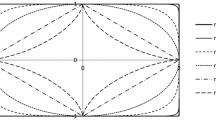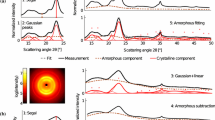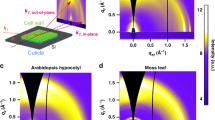Abstract
The Rietveld method is a versatile tool to parameterize the fine structure of crystallites analyzed by diffraction. The method relies on a crystallographic model representing what is known a priori, and free coefficients determined from fits to experimental data. This article provides an introduction to Rietveld analysis of celluloses from higher plants that are adequately described by the cellulose Iβ crystal structure. Possibilities of Rietveld analysis have been recently enhanced by a tailored crystallographic model and computational algorithm, named Cellulose Rietveld Analysis for Fine Structure (CRAFS). From each two-dimensional diffraction pattern, CRAFS automated analysis outputs unit cell parameters, crystallite sizes, peak profile functions, integrated crystalline intensity (proportional to cellulose degree of crystallinity), and crystallite orientation distribution function. Two of the major hurdles for analysis of plant cellulose—overlapping of diffraction peaks and preferred crystallite orientation—are consistently treated by the two-dimensional Rietveld analysis. Hence, the method is a unique tool to explore cellulose fine structural variability, with differences arising from specimen conditioning, processing, and biological origins.




Similar content being viewed by others
References
Abe K, Yamamoto H (2005) Mechanical interaction between cellulose microfibril and matrix substance in wood cell wall determined by X-ray diffraction. J Wood Sci 51:334–338
Bunge H (1993) Texture analysis in materials science: mathematical methods. Cuvillier Verlag, Göttingen
Davidson TC, Newman RH, Ryan MJ (2004) Variations in the fibre repeat between samples of cellulose I from different sources. Carbohydr Res 339:2889–2893
Delhez R, Mittemeijer EJ, De Keijser TH, Rozendaal HCF (1977) Correction for the angle dependence of Lorentz, polarization and structure factors in x-ray diffraction line profiles. J Phys E: Sci Instrum 10:784–785
Delhez R, de Keijser TH, Langford JI, Louër D, Mittemeijer EJ, Sonneveld EJ (1993) Crystal imperfection broadening and peak shape in the Rietveld Method. In: Young RA (ed) The Rietveld method. Oxford University Press, New York, pp 132–166
Driemeier C, Bragatto J (2013) Crystallite width determines monolayer hydration across a wide spectrum of celluloses isolated from plants. J Phys Chem B 117:415–421
Driemeier C, Calligaris GA (2011) Theoretical and experimental developments for accurate determination of crystallinity of cellulose I materials. J Appl Cryst 44:184–192
Driemeier C, Pimenta MTB, Rocha GJM et al (2011) Evolution of cellulose crystals during prehydrolysis and soda delignification of sugarcane lignocellulose. Cellulose 18:1509–1519
Driemeier C, Santos WD, Buckeridge MS (2012) Cellulose crystals in fibrovascular bundles of sugarcane culms: orientation, size, distortion, and variability. Cellulose 19:1507–1515
Ferrari M, Lutterotti L (1994) Method for the simultaneous determination of anisotropic residual stresses and texture by X-ray diffraction. J Appl Phys 76:7246–7255
Hammersley AP (2005) FIT2D. ESFR, Grenoble, France. (http://www.esrf.eu/computing/scientific/FIT2D/)
Hori R, Wada M (2005) The thermal expansion of wood cellulose crystals. Cellulose 12:479–484
Hosemann R (1950) Der ideale Parakristall und die von ihm gestreute kohärente Röntgenstrahlung. Zeitschrift für Physik 128:465–492
Hosemann R, Hindeleh AM (1995) Structure of crystalline and paracrystalline condensed matter. J Macromol Sci B Phys 34:327–356
Ioelovitch M (1992) Zur übermolekularen Struktur von nativen und isolierten Cellulosen. Acta Polym 43:110–113
Keckes J, Burgert I, Frühmann K et al (2003) Cell-wall recovery after irreversible deformation of wood. Nat Mater 2:810–814
Langford JI, Wilson AJC (1978) Scherrer after sixty years: a survey and some new results in the determination of crystallite size. J Appl Cryst 11:102–113
Leppänen K, Andersson S, Torkkeli M et al (2009) Structure of cellulose and microcrystalline cellulose from various wood species, cotton and flax studied by X-ray scattering. Cellulose 16:999–1015
Nishiyama Y, Langan P, Chanzy H (2002) Crystal structure and hydrogen bonding system in cellulose Iβ from synchrotron X-ray and neutron fiber diffraction. J Am Chem Soc 124:9074–9082
Nishiyama Y, Johnson GP, French AD (2012) Diffraction from nonperiodic models of cellulose crystals. Cellulose 19:319–336
Okano T, Koyanagi A (1986) Structural variation of native cellulose related to its source. Biopolymers 25:851–861
Oliveira R, Driemeier C (2013) CRAFS: a model to analyze two-dimensional X-ray diffraction patterns of plant cellulose. J Appl Cryst. doi:10.1107/S0021889813014805
Revol J-F, Gancet C, Goring DAI (1982) Orientation of cellulose crystallites in the S2 layer of spruce and birch wood cell walls. Wood Sci 14:120–126
Rietveld HM (1967) Line profile of neutron powder-diffraction peaks for structure refinement. Acta Cryst 22:151–152
Rietveld HM (1969) A profile refinement method for nuclear and magnetic structures. J Appl Cryst 2:65–71
Roe R-J (2000) Methods of X-ray and neutron scattering in polymer science. Oxford University Press, New York
Simonović J, Stevanic J, Djikanović D et al (2011) Anisotropy of cell wall polymers in branches of hardwood and softwood: a polarized FTIR study. Cellulose 18:1433–1440
Skaar C (1988) Wood-water relations. Springer, Berlin
Thygesen A, Oddershede J, Lilholt H et al (2005) On the determination of crystallinity and cellulose content in plant fibres. Cellulose 12:563–576
Viëtor RJ, Newman RH, Ha M-A et al (2002) Conformational features of crystal-surface cellulose from higher plants. Plant J 30:721–731
Von Dreele RB (1997) Quantitative texture analysis by Rietveld refinement. J Appl Cryst 30:517–525
Warren BE (1990) X-ray diffraction. Dover, New York
Warren BE, Averbach BL (1950) The effect of cold-work distortion on X-ray patterns. J Appl Phys 21:595–599
Welberry TR, Miller GH, Carroll CE (1980) Paracrystals and growth-disorder models. Acta Cryst A 36:921–929
Yinghua W (1987) Lorentz-polarization factor for correction of diffraction-line profiles. J Appl Cryst 20:258–259
Young RA (ed) (1993) The Rietveld method. Oxford University Press, New York
Zabler S, Paris O, Burgert I, Fratzl P (2010) Moisture changes in the plant cell wall force cellulose crystallites to deform. J Struct Biol 171:133–141
Acknowledgments
Research supported by CNPq and FAPESP (Grant 2010/05523-3).
Author information
Authors and Affiliations
Corresponding author
Rights and permissions
About this article
Cite this article
Driemeier, C. Two-dimensional Rietveld analysis of celluloses from higher plants. Cellulose 21, 1065–1073 (2014). https://doi.org/10.1007/s10570-013-9995-2
Received:
Accepted:
Published:
Issue Date:
DOI: https://doi.org/10.1007/s10570-013-9995-2




